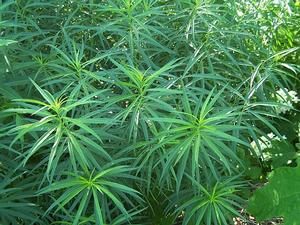View All Plants :: View All QUACKIN' GRASS INTRODUCTIONS :: View All SHADE PERENNIALS :: View All SUN PERENNIALS

Amsonia tabernaemontana var. salicifolia 'Green Ostrich' - Eastern Bluestar from Quackin Grass Nursery
Amsonia tabernaemontana var. salicifolia 'Green Ostrich'
Eastern Bluestar
Plant Type:
QUACKIN' GRASS INTRODUCTIONSAmsonia tabernaemontana var. salicifolia 'Green Ostrich' - OUR INTRODUCTION not available elsewhere) We found this curious perennial in with clumps of A. taberrnaemontana v. salicifolia in one of our gardens with a small stand of A. hubrichtii not far away. Intermediate leaves between A. hubrichtii and tabernaemontana are evident (see picture). The growth habit is that of A. tabernaemontana including size, habit and even the branching at and near tops of stems. Typical terminal and lovely blue flowers flaunt atop stems in late spring to early summer. Whether this is a hybrid between A. taberrnaemontana v. salicifolia and A. hubrichtii or a genetic variant of pure A. taberrnaemontana v. salicifolia with no other influences we do not know. Though there is possible hubrichtii influence it has all the stamina, vigor, habit and overall look of A. taberrnaemontana. And, of course, the deer don't like it, the butterflies do and it turns beautiful showy gold in autumn. In the garden it looks like a softer looking A. tabernaemontana or an exceptionally robust A. hubrichtii. Established potted Amsonia from division or cutting.
Characteristics and Attributes for Amsonia tabernaemontana var. salicifolia 'Green Ostrich'
Season of Interest (Flowering)
- Late Spring / Early Summer
Season of Interest (Foliage)
- Spring / Summer / Autumn
Autumn Interest
- Autumn Leaf Color
Nature Attraction
- Deer Resistant
- Honey Bees & Native Bees
- Butterflies
Light
- Morning Sun / Afternoon Shade
- Shade Tolerant
- Full Sun
- Mostly Sunny
Attributes
- Natural Garden
- Cottage Garden
- Border
- Meadow / Field
- Massing
- Wildlife Garden
Growth Rate in the Garden
- Moderately Fast
Soil
- Draining
- Fertile
Origins
- Garden Origin
Propagated By
- Cutting Grown
- Division

